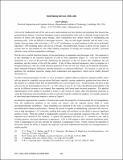Interfacing devices with cells
Author(s)
Voldman, Joel
DownloadVoldman-2009-Interfacing devices with cells.pdf (1.535Mb)
PUBLISHER_POLICY
Publisher Policy
Article is made available in accordance with the publisher's policy and may be subject to US copyright law. Please refer to the publisher's site for terms of use.
Terms of use
Metadata
Show full item recordAbstract
To detect electrical properties of cells, we have developed a method called iso-dielectric separation (IDS), where cells are placed in a spatially varying electric field and a spatially varying conductivity gradient that forces them to the location in a channel where their net polarizability (p) is zero. At that location, the force on the cell, given by the dielectrophoretic force (F = p·Nabla E) will go to zero. Cells with different polarizabilities will end up in different locations in the channel, thus separating cells based upon electrical properties. The physical implementation of the method is described in Figure 3, and consists of a glass chip with patterned electrodes to create the field, along with microfluidics to deliver cells and create the conductivity gradient.
Date issued
2009-06Department
Massachusetts Institute of Technology. Department of Electrical Engineering and Computer ScienceJournal
67th Device Research Conference Digest
Publisher
Institute of Electrical and Electronics Engineers (IEEE)
Citation
Voldman, Joel. “Interfacing Devices with Cells.” IEEE, 2009. 243–244. © Copyright 2009 IEEE
Version: Final published version
ISBN
978-1-4244-3528-9
978-1-4244-3527-2